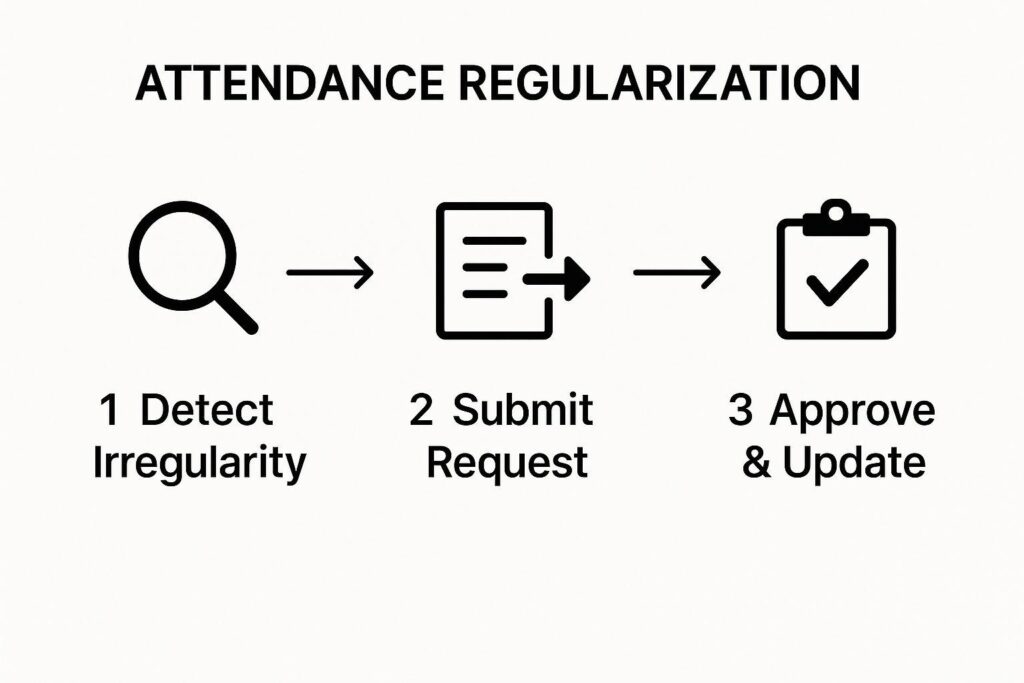Contents
- Attendance Regularization: Simplify and Ensure Compliance
- Why Attendance Regularization Is a Game Changer
- The Real Impact on Morale and Operations
- Shifting from Reactive to Proactive
- Crafting a Fair and Compliant Regularisation Policy
- Defining What Qualifies for Regularisation
- Setting Clear Submission Timelines
- Documenting Roles and Responsibilities
- Building an Efficient Regularisation Workflow
- Designing a Simple Request Form
- Mapping the Approval Chain
- Training Your Team for Smooth Adoption
- Choosing the Right Attendance Management Technology
- Core Features You Cannot Afford to Ignore
- Matching Technology to Your Unique Needs
- Avoiding Common Regularisation Mistakes
- Vague Communication and its Consequences
- Overlooking The Power of Data
- From Common Pitfalls to Best Practices
- Answering Your Team’s Attendance Regularization Questions
Attendance Regularization
Attendance Regularization: Simplify and Ensure Compliance
Let’s be honest, attendance tracking can be a real headache. Especially now, with so many of us working flexibly or fully remote. A missed punch-in here, a forgotten clock-out there—it happens. This is where attendance regularization comes in. It’s simply the process of fixing those little errors and gaps in an employee’s attendance records.
But don’t let the simple definition fool you. Getting this right is about so much more than just correcting a timesheet.
Why Attendance Regularization Is a Game Changer

A well-oiled attendance regularization process is less of an admin task and more of a strategic asset. Think about it. It’s the difference between a system that feels fair and one that feels punitive.
When your team knows there’s a clear, consistent way to sort out genuine mistakes—like a forgotten swipe card after a client meeting or a system glitch—it builds a huge amount of trust. It shows them the company cares about getting things right, not just catching people out.
The Real Impact on Morale and Operations
Without a proper process, you’re inviting chaos. One manager might let things slide while another is a stickler for the rules, quickly leading to feelings of favouritism. An employee who genuinely forgot to clock in could see their pay docked incorrectly, and that kind of thing is incredibly frustrating.
Little issues like these, when they happen over and over, are what slowly chip away at your company culture.
In India, this is a massive deal, especially for companies managing large, spread-out teams. With employee engagement being a constant challenge, a fair and transparent attendance system can be a surprising morale booster. It just makes for a more positive, open work environment. You can find more insights on workforce engagement in India to see the bigger picture.
A proactive attendance regularization policy isn’t about policing your team. It’s about creating a safety net. This net protects both the employee and the company, making sure everyone is paid correctly and the records are squeaky clean.
Shifting from Reactive to Proactive
The goal is to stop the mad scramble at the end of the month to fix timesheets. A modern approach makes regularization a smooth, everyday part of work. This small shift brings a lot of stability and makes for a healthier culture.
So, what does a good system actually look like? A quick look at the essential elements every successful attendance regularization process needs.
Pillars of a Modern Regularization System
| Pillar | What It Achieves |
|---|---|
| Transparency | Everyone knows the process, the deadlines, and why a request might be approved or denied. No mystery. |
| Consistency | The rules apply to everyone, from the newest hire to the senior manager. Fairness is non-negotiable. |
| Efficiency | The process is quick and simple, using technology to cut down on manual work for employees, managers, and HR. |
When you start seeing it as a tool for building fairness instead of just another administrative chore, you can turn a common operational headache into a real advantage.
Crafting a Fair and Compliant Regularisation Policy

A policy is more than just a document; it’s a promise of fairness and clarity you make to your team. Without clear guidelines, your attendance regularisation process can quickly become a minefield of confusion, frustration, and inconsistency.
The real goal here is to build a framework that everyone understands. It should be simple for managers to apply consistently and robust enough to protect the organisation legally. This means getting rid of vague rules and creating specific, actionable guidelines that become the single source of truth for handling any attendance issue, leaving no room for guesswork.
Defining What Qualifies for Regularisation
First things first, you need to clearly spell out what counts as a valid reason for an attendance regularisation request. If you leave this open to interpretation, you’ll find employees trying to use the system to cover for simple tardiness or other non-genuine reasons. You have to be specific about the situations your policy will cover.
Here are some common and perfectly acceptable reasons we see organisations include:
- System or Technical Failures: The biometric scanner was on the fritz, or maybe the mobile app glitched during clock-in. It happens.
- Official On-Duty Assignments: An employee was out at a client meeting, attending a conference, or working from another company site as part of their job.
- The Honest Mistake: A genuine slip-up where an employee simply forgot to clock in or out but was verifiably present and working their shift.
- Power or Internet Outages: Especially for your remote team, documented service disruptions that prevent them from logging in on time should be covered.
By defining these scenarios upfront, you give your managers the confidence to make quick, consistent decisions. It also clearly sets expectations for employees on when it’s appropriate to hit that “submit request” button.
Setting Clear Submission Timelines
In the world of payroll, timing is everything. A request that trickles in weeks after the fact can throw a real spanner in the works, creating an administrative headache. Your policy must lock down a firm but reasonable deadline for submissions.
A common best practice is to set a 48- to 72-hour window. This is the sweet spot. It gives employees enough time to spot a discrepancy and submit a request while the details are still fresh in everyone’s mind, and it prevents a mad dash right before the pay cycle closes.
This deadline isn’t just for your convenience; it’s about accuracy. A manager is far more likely to remember if someone was at their desk yesterday versus trying to recall the details from a week ago.
This kind of precision is vital when you consider the sheer scale of workforce management in India. With the Labour Force Participation Rate for those aged 15 and above sitting at 54.8% as of May 2025, managing a large, diverse workforce demands tight processes to keep payroll accurate and compliant.
Documenting Roles and Responsibilities
So, who does what? Your policy needs to be crystal clear about the responsibilities for each person in the regularisation workflow. This is how you prevent bottlenecks and ensure everyone is accountable.
A typical, effective breakdown looks something like this:
- The Employee’s Role: Their job is to promptly identify errors in their attendance records and submit a regularisation request within the deadline. They must also provide a clear reason and any necessary proof.
- The Manager’s Role: They are the first line of approval. They need to verify if the request is legitimate based on their knowledge of the employee’s schedule and tasks, then approve or reject it quickly.
- HR’s Role: HR acts as the final checkpoint and the owner of the process. They make sure the policy is being applied consistently across all departments, step in to handle any escalations, and audit the entire process for compliance.
This clear division of labour is what makes the whole system run smoothly. It also ensures the right people are making the right decisions. For more complex hiring situations, understanding a candidate’s journey and experience can also offer great insights into building employee-centric processes right from day one.
Building an Efficient Regularisation Workflow
A solid policy is a great starting point, but it’s the workflow that truly brings it to life. Think of an efficient attendance regularisation process as a clear, frictionless path that takes a request from an employee’s screen, to a manager’s inbox, and finally into the payroll system without a single hiccup. It’s all about creating a smooth journey that gets rid of administrative headaches.
Without a well-defined workflow, even the best-laid policies fall apart. Requests vanish into endless email threads, managers forget to hit ‘approve’, and HR ends up scrambling to fix everything at the end of the month. A structured workflow, on the other hand, ensures every request is properly tracked, actioned, and closed out on time.
Designing a Simple Request Form
The whole process kicks off with the request form. Since this is the employee’s main point of contact with the system, it has to be incredibly simple and intuitive. A clunky, confusing form is the first roadblock you can put in your own way.
The trick is to capture just enough information without making it a chore. A good form should always include:
- Date and Time of Discrepancy: The specific day and time that needs fixing.
- Reason for Regularisation: A dropdown menu with standard options (like “Forgot to Clock Out,” “Client Meeting,” or “System Error”) keeps things fast and consistent.
- A Brief Justification Field: A small text box is perfect for the employee to add a quick sentence of necessary context.
Overly complex forms just create more work and discourage people from submitting their requests promptly. Keep it lean, and focus only on the essential details a manager needs to make a quick, informed decision.
This infographic shows a typical flow for an automated attendance regularisation workflow.

As you can see, an automated system logically moves a request from detection to final approval, cutting down on manual work at every single stage.
Mapping the Approval Chain
So, once an employee hits ‘submit’, where does the request go? The approval chain needs to be logical and crystal clear. From what we’ve seen, the most effective structure is a simple two-step process that empowers managers while keeping HR in the loop for oversight.
First, the request should land directly with the employee’s immediate manager. They are in the best position to know if the request is legitimate—after all, they know if a team member was actually at an off-site client meeting. This first check weeds out any mistaken or fraudulent requests right away.
Only after the manager gives the green light should the request move to HR. At this point, HR’s role isn’t to re-evaluate the request’s validity. Instead, they act as a final checkpoint for policy compliance and ensure the corrected data is updated in the payroll system. This clear hierarchy prevents delays and makes it obvious who is responsible for what.
A well-designed workflow with automated notifications can slash the time spent on manual follow-ups by over 50%. Instead of chasing approvals, the system gently nudges the right people at the right time, keeping the entire process moving.
Training Your Team for Smooth Adoption
Finally, you can’t just launch a new workflow and expect everyone to get it. Clear communication and training are non-negotiable.
Set aside time for brief training sessions for both employees and managers. For organisations looking to scale their operations, having streamlined internal processes like this is just as important as their external recruitment strategies. If you’re exploring large-scale hiring, understanding the benefits of recruitment process outsourcing can offer valuable parallels in process efficiency.
Show employees exactly how to fill out the form and track where their request is. For managers, the focus should be on how to quickly review and approve requests within the system. Providing simple job aids, like a one-page PDF guide, gives everyone a handy reference and ensures your new process is adopted smoothly and successfully.
Choosing the Right Attendance Management Technology
Let’s be honest: moving away from manual spreadsheets and endless email chains is the single biggest improvement you can make to your attendance regularisation workflow. The right technology doesn’t just speed things up; it brings a level of accuracy and consistency that manual processes can never hope to match. It’s about turning a frustrating administrative chore into a smooth, almost invisible operation.
For any organisation, big or small, the real challenge is finding a system that actually fits your needs. A startup in a single office has completely different problems to solve than a large manufacturing firm juggling multiple sites and complex shift patterns. Investing in the right tool makes the process dead simple for employees while giving managers and HR the clear, actionable data they need.
Core Features You Cannot Afford to Ignore
When you start looking at software, it’s easy to get distracted by all the bells and whistles. My advice? Forget the flashy stuff for a moment and focus on the core functionalities that will directly solve your biggest attendance headaches. A great system is built on a foundation of reliability and ease of use.
Here are the absolute must-haves:
- Mobile Access: In a world with field teams and remote workers, employees need to be able to submit regularisation requests straight from their phones. It’s that simple.
- Automated Approval Workflows: The system should be smart enough to automatically route requests to the correct manager and then to HR, sending reminders so no one has to chase anyone.
- Real-Time Dashboards: Managers need a quick, visual way to see pending requests and spot attendance patterns for their team at a glance.
- Payroll Integration: The ability to seamlessly push corrected attendance data to your payroll system is non-negotiable. This single feature eliminates soul-crushing manual data entry and prevents costly mistakes.
The most effective attendance management systems have been shown to reduce manual intervention by over 80%. Think about all the hours that frees up for your HR team to focus on strategic work instead of chasing paperwork.
Matching Technology to Your Unique Needs
The Indian market has really leaned into adopting advanced software to manage these complexities. This is especially true for SMEs and startups that are dealing with varied shifts, remote employees, and multiple locations all at once. The right software isn’t just for simplifying corrections; it’s critical for maintaining compliance with local labour laws. For a deeper dive, you can explore a detailed guide on the best attendance software in India.
Here’s a quick look at how different platforms stack up based on key features.
This kind of comparison shows how different tools are built for specific business needs, whether it’s GPS tracking for a travelling sales team or biometric integration for a factory floor.
Before you make a decision, take the time to map out your company’s unique scenarios. Do you have a large sales team that’s always on the road? You’ll need rock-solid GPS and mobile clock-in features. Do you run three shifts a day? Your system absolutely must handle complex scheduling and overtime rules without breaking a sweat. Choosing a platform that aligns with how your business actually operates is the only way to guarantee a successful rollout and a genuinely efficient attendance regularisation process.
Avoiding Common Regularisation Mistakes

Even with a solid policy and the best technology, things can still go sideways. The real success of your attendance regularisation process often hinges on dodging a few common but critical errors. These aren’t complex system failures; they’re human mistakes that can easily undermine fairness and create a mountain of administrative friction.
The biggest mistake we see, time and again, is inconsistency. When one manager approves a late submission but another sticks strictly to the deadline, it creates a palpable sense of unfairness. This erodes trust and makes the entire policy feel arbitrary, which is the last thing you want.
Another frequent headache is delayed approvals. An employee submits a valid request, but it just sits in a manager’s inbox for days. This not only frustrates the employee but also forces a last-minute scramble for HR right before payroll processing. A simple fix suddenly becomes a major problem.
Vague Communication and its Consequences
Failing to communicate the “why” behind your policy is a recipe for poor adoption. If employees see regularisation as just another bureaucratic hurdle to jump through, they won’t engage with it properly. You have to clearly explain how it ensures accurate pay and maintains fairness for everyone.
It’s the same when a request is rejected. A simple “denied” message just won’t cut it. Managers must provide a clear, concise reason that ties directly back to the policy. Was it submitted too late? Was the reason provided invalid? Specific feedback helps employees learn the rules and stops them from making the same mistake again.
The most effective attendance regularisation policies are built on clear communication. A well-informed team that understands the rules and the reasons behind them is far more likely to follow the process correctly, reducing errors by a significant margin.
Overlooking The Power of Data
Your attendance regularisation data is a goldmine of operational insight, yet most organisations completely ignore it. Are you noticing a pattern of missed clock-ins from a particular department? This might not be a discipline issue at all—it could point to a faulty biometric scanner or unclear instructions for a new team.
Analysing this data helps you move from reactive problem-solving to proactive improvements. If your team is growing quickly, for instance, these insights become absolutely vital. Understanding employee patterns is similar to how data-driven recruitment process outsourcing can lead to high-impact hiring, as both rely on spotting trends to boost efficiency.
To help you spot these issues before they become ingrained problems, we’ve put together a quick look at common pitfalls and the better practices you should adopt.
From Common Pitfalls to Best Practices
| Common Mistake | Recommended Best Practice |
|---|---|
| Inconsistent rule application by managers. | Provide clear guidelines and regular training for all managers to ensure uniform enforcement. |
| Slow approval cycles causing delays. | Implement automated reminders and set clear expectations for manager response times in your policy. |
| Vague reasons for rejecting a request. | Require managers to select a specific reason or provide a brief, policy-based explanation for every denial. |
| Ignoring patterns in regularisation data. | Schedule quarterly reviews of attendance data to identify and address systemic issues proactively. |
By actively steering clear of these common traps, you ensure your attendance regularisation process remains a tool for fairness and efficiency, rather than a source of constant frustration. It’s all about building a system that is not only robust but also trusted by your entire team.
Answering Your Team’s Attendance Regularization Questions
Even with the best policy in place, questions are bound to pop up. When you’re dealing with people’s time and pay, clarity is everything. Let’s walk through some of the common questions managers and employees have about attendance regularization.
Getting these details sorted helps everyone feel the process is fair and straightforward.
This is probably the most frequent question we hear. From our experience, a 24 to 72-hour window is the sweet spot.
Why this timeframe? It’s short enough that the missed punch or the reason for being off-site is still fresh in everyone’s memory. This helps ensure accuracy. But it also gives enough breathing room for busy schedules, preventing a last-minute scramble that can give your payroll team a major headache. If you let it go any longer, you risk a pile-up of approvals right before the payroll cycle closes.
When you see the same employee submitting request after request, it’s a red flag. But it’s usually not a sign of a problem employee; it’s a symptom of a problem elsewhere. Just rubber-stamping these requests is a missed opportunity.
Instead of getting frustrated, this is a manager’s cue to have a supportive chat. Is their access card faulty? Are they confused about logging in at a new worksite? Maybe there’s a personal issue making their mornings difficult. A quick, proactive conversation can solve the root cause, which is always better than just patching up the timesheet week after week.
Think of frequent regularization requests as a data point. This data isn’t about performance; it’s an indicator that a process, a tool, or a personal situation needs a closer look. A proactive chat can prevent a small issue from becoming a larger one.
Absolutely. In fact, you should reject requests that don’t fit the policy. The key isn’t the rejection itself, but doing it with consistency and transparency.
A request might be rejected for a few common reasons:
No valid reason: The justification provided doesn’t line up with the approved reasons in your policy.
It’s too late: The request came in well after your 24-72 hour deadline.
It’s a policy violation: The employee is trying to cover an unapproved absence, not correct a simple timekeeping error.
The most critical part? Clearly communicate why it was rejected. A brief, polite explanation that points back to the company policy helps the employee understand, reinforces that the system is fair, and reduces the chance they’ll make the same mistake again.
There isn’t a single law called the “Attendance Regularization Act.”
Instead, the practice is governed by foundational labour laws, like the Shops and Establishment Act that applies in your state.
These laws require employers to keep accurate, up-to-date records of every employee’s work hours. This isn’t just about good bookkeeping; it’s legally essential for calculating correct wages, overtime pay, and leave entitlements.
A solid attendance regularisation process is the tool you use to guarantee those records are precise, keeping your organisation fully compliant.
Ready to build a world-class team with processes that attract and retain top talent? Taggd can help you streamline your recruitment and HR functions. Discover our RPO solutions at https://taggd.in.
